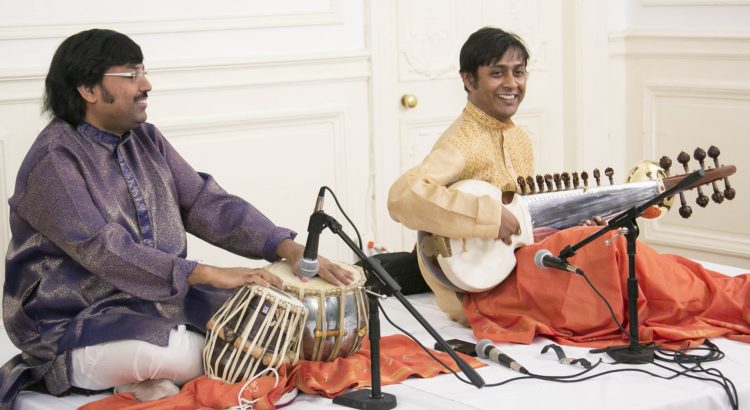“Hindustani classical music is developed through two interwoven elements: Raga and Tala. Raga is a melodic element and is crafted by improvisation on fixed patterns of ascent and descent. Tala is the rhythmic structure on which the melody is laid.” So to my understanding, Tala is the template to which Raga molds in the artist’s own creative original way.
The Strings of India concert this past Friday in Ann Arbor expressed this style of music using the Sarod, a 25 string fretless ethnic instrument, and the Tabla, a membranophone percussion instrument that plays by unique configurations of the palms and fingers and requires constant retuning. Two artists dressed in traditional Indian attire sat poised at the front of the orange and yellow accented Hussey Room, one with the Sarod and the other with the Tabla. This genre of music was new to me. To be candid, I felt pretty naive hearing this performance. I had no gauge of what was considered good Indian music; I had never listened to it. Basic questions filed through my head. What are these instruments? Well, I could deduce that a 25 string instrument must be difficult to master. Playing my 6 string is hard in itself, and I have frets to measure where the notes are…so imagine more than 4 times the strings on a guitar minus the indications of the notes given by frets and that roughly equates the complexity of the Sarod. The Tabla looks like a simple goatskin circle that generates different sounds depending on where you strike it…so knowing where to strike it to produce the desired output must be quite a feat. How good are these guys on stage? Turns out, the two gentlemen before me were globally recognized as prestigious musicians, and I had hardly understood the magnitude of their talent until this Friday. Apratim Majumdar, the Sarod player, and Amit Kumar Chatterjee, the Tabla player, have very strong, extensive music backgrounds and are prominent in the music world. They have celebrity status in India (I confirmed this with a coworker from India), and after listening to them gain momentum in their performance, their remarkable talent becomes obvious.
It’s amazing how different the lives of these musicians are from mine. Their practice focuses on intimate time with just themselves and their instrument. Mine is based in the Ugli, study collaborations, and standardized tests. I wonder how they chose to dedicate their lives to mastering an instrument. I wonder if their interest ever tires after hours and hours of rehearsing. I wonder if there such thing as being the best _______ in the world. Best Sarod player. Best Tabla player. Best surgeon. Best chef. Best employee. Best friend. Is being the best based on statistics…or what? In that case, how can you test music in a statistical way? Maybe by the accuracy of notes…no! Hindustani classical music is improvisation. Thus, there is not a standard correct way to play because there is no script for them to follow. Surgery faces complications in the case of emergency so the surgeon must improvise. If every chef followed the same recipe, all food would taste the same. Chefs improvise. Employees don’t deal with the same exact case every day so they improvise. Every friend is different and so are his or her experiences, so friendship adapts to these changing circumstances by improvising. So how can we grade each other based on a standard when life is improvisation?????
I’m thankful to be at a school that fosters my interest to explore the world through art and music in the closeness of the city I call a home, Ann Arbor.
Special thanks to SPICMACAY, the Society for Promotion of Indian Classical Music and Culture Amongst Youth. I and crowds of people are able to see performances at the University of Michigan by Indian artists from across the globe for free because of this group’s efforts. Through events like Strings of India, the organization promotes an understanding of the richness and depth of Indian culture and has expanded immensely since its establishment in 1972. Groups like this help make a big world feel small.
Here’s a video of one of Apratim Majumdar and Amit Kumar Chatterjee’s performances.



Leave a Reply
Be the First to Comment!